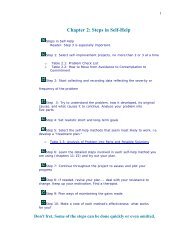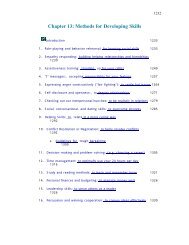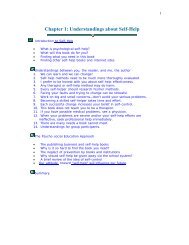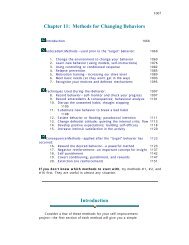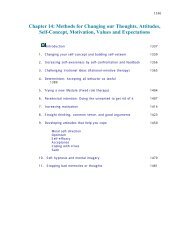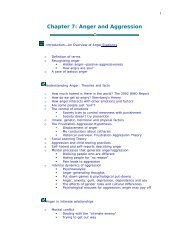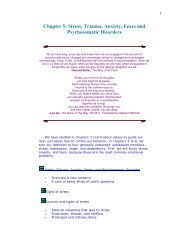Chapter 3: Values and Morals:Guidelines for living - Psychological ...
Chapter 3: Values and Morals:Guidelines for living - Psychological ...
Chapter 3: Values and Morals:Guidelines for living - Psychological ...
You also want an ePaper? Increase the reach of your titles
YUMPU automatically turns print PDFs into web optimized ePapers that Google loves.
Hogan (1973) believes that moral behavior is determined by five<br />
factors: (1) Socialization: becoming aware as a child of society's <strong>and</strong><br />
parents' rules of conduct <strong>for</strong> being good. (2) Moral judgment:<br />
learning to think reasonably about our own ethics <strong>and</strong> deliberately<br />
deciding on our own moral st<strong>and</strong>ards. (3) Moral feelings: the<br />
internalization of our moral beliefs to the degree that we feel shame<br />
<strong>and</strong> guilt when we fail to do what we "should." (4) Empathy: the<br />
awareness of other people's situation, feelings, <strong>and</strong> needs so that one<br />
is compelled to help those in need. (5) Confidence <strong>and</strong> knowledge:<br />
knowing the steps involved in helping others <strong>and</strong> believing that one is<br />
responsible <strong>for</strong> <strong>and</strong> capable of helping.<br />
There is not much you can do now about Hogan's first factor--your<br />
own upbringing. Even though poor parenting is clearly associated with<br />
poor work habits, drug use, gangs, <strong>and</strong> irresponsibility, you have to<br />
accept whatever childhood you had. According to Mussen <strong>and</strong><br />
Eisenberg-Berg (1977), helpful children usually have nurturing parents<br />
who frequently act on their giving, caring nature within the family <strong>and</strong><br />
with outsiders. These parents set high dem<strong>and</strong>s on the child,<br />
frequently asking him or her to help or to "take care of" another<br />
person, but they do not use "power" in the <strong>for</strong>m of physical <strong>for</strong>ce or<br />
threats to control their child. Instead, the reasons <strong>and</strong> ethics <strong>for</strong> the<br />
desired behavior or recommended morals are carefully explained. They<br />
point out the "rights" <strong>and</strong> "wrongs" of the child's daily actions, while<br />
<strong>living</strong> up to their own st<strong>and</strong>ards of honesty, concern <strong>for</strong> others, <strong>and</strong><br />
fairness. If you were raised in this way, thank your parents. If you<br />
weren't, underst<strong>and</strong> your parents, <strong>and</strong> set about providing yourself<br />
with the learning experiences (you can talk to yourself like a parent)<br />
you may need to become a helping person.<br />
There are many factors that influence your daily morality, which<br />
you can control. Let's now explore Hogan's second factor--the moral<br />
judgments needed to develop a good value system of your own. The<br />
best way <strong>for</strong> you to do this is by starting to draft your own set of<br />
beliefs <strong>and</strong> values as you consider the following sections. At the end of<br />
the chapter, you will have an outline <strong>for</strong> a useful value system.<br />
Writing Your Own Philosophy of Life<br />
According to Jewish custom, a person should write two wills: one<br />
to give away property <strong>and</strong> another to pass on his or her values. What<br />
values do you want to live by <strong>and</strong> have your children adopt? I suggest<br />
you give this important matter a great deal of thought <strong>and</strong> then outline<br />
a philosophy to guide your own <strong>and</strong> your children's lives (if they<br />
should choose to listen).<br />
First, some definitions of common terms. Beliefs are our own<br />
expectancies (realistic or not) <strong>and</strong> underst<strong>and</strong>ings (accurate or not)<br />
15



